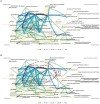One Health Education Nexus: enhancing synergy among science-, school-, and teacher education beyond academic silos
- PMID: 38585291
- PMCID: PMC10995387
- DOI: 10.3389/fpubh.2023.1337748
One Health Education Nexus: enhancing synergy among science-, school-, and teacher education beyond academic silos
Abstract
Introduction: The fact that the daily lives of billions of people were affected by the medical, social, and political aspects of the SARS-CoV-2 pandemic shows the need to anchor the understanding of One Health in society. Hence, promoting awareness and deepening the understanding of the interrelation between human health, animal health, and ecosystems must be accomplished through quality education, as advocated by UN Sustainable Development Goal 4. The often-questioned and discussed measures taken by governments to control the global pandemic between 2020 and 2023 can be seen as an opportunity to meet the educational needs of civil society solutions in multi-stakeholder settings between public, universities, and schools.
Methods: This paper focuses on the integration of One Health principles in educational frameworks, particularly within the context of the higher education teaching framework "Teaching Clinic." This master-level course in the domain of pre-service teacher education serves as a potent vehicle for facilitating One Health Education, bridging the gap between research, higher education, and schools. Through the presentation of two case studies, this article demonstrates how the Teaching Clinic approach fosters interdisciplinary perspectives and provides a dynamic learning environment for pre-service teachers, as well as for pupils involved in the educational process.
Results: In both cases, the integration of educational One Health school teaching-learning settings effectively enhanced pupils' understanding of complex topics and engaged them in active learning experiences. Pre-service teachers played a crucial role in developing, implementing, and evaluating these interventions. In Case I, pupils demonstrated proficiency in analyzing data and evaluating mathematical models, while in Case II, the chosen instructional approach facilitated One Health knowledge acquisition and enjoyment among pupils. These results underscore the potential of the One Health Teaching Clinic as a valuable educational framework for enhancing teaching and learning outcomes for pre-service teachers and fostering pupil engagement in socio-scientific One Health-related topics.
Discussion: The discussion delves into the significance of breaking down disciplinary silos and the crucial role of teacher education in promoting a holistic approach to education, emphasizing the intersectionality of One Health Education and Education for Sustainable Development. This article underpins the significance of collaborative efforts across multiple (scientific) disciplines and across secondary and tertiary education levels to reach a nexus. Moreover, it emphasizes the alignment of this approach with the 2030 Agenda, Education for Sustainable Development, and Sustainable Development Goals, highlighting the potential for collective action toward a more sustainable future.
Keywords: Agenda 2030; Education for Sustainable Development (ESD); One Health; Sustainable Development Goals (SDGs); biology education; science education; teacher education; teaching clinic.
Copyright © 2024 Hobusch, Scheuch, Heuckmann, Hodžić, Hobusch, Rammel, Pfeffer, Lengauer and Froehlich.
Conflict of interest statement
The authors declare that the research was conducted in the absence of any commercial or financial relationships that could be construed as a potential conflict of interest. The author(s) declared that they were an editorial board member of Frontiers, at the time of submission. This had no impact on the peer review process and the final decision.
Figures




References
-
- Cook R, Karesh W, Osofsky S. One world, one health: building interdisciplinary bridges to health in a globalized world. Bronx, NY: (2004) Available at: http://www.oneworldonehealth.org/sept2004/owoh_sept04.html.
Publication types
MeSH terms
LinkOut - more resources
Full Text Sources
Miscellaneous

